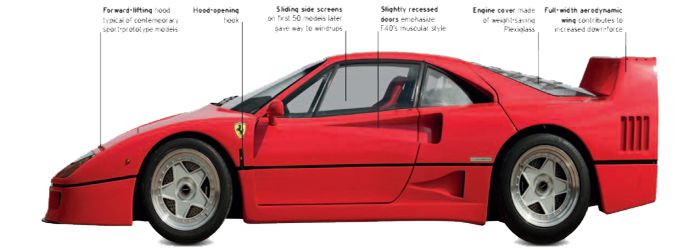It was fitting that the Ferrari F40 was the final model commissioned by Enzo Ferrari before his death in 1988. Launched in 1987 to commemorate the marque’s 40th anniversary, this was a supercar that, true to the spirit of 2 Commendatore himself, incorporated racetrack technology in a road-going car to create a truly exhilarating package.

Ferrari’s army of devoted fans agreed, with a lengthy waiting list and wealthy customers willing to pay up to a million pounds sterling to get their hands on the fastest street-legal production car in the world.

Made in Modena
Known as the Cavallino Rampante, Ferrari’s Prancing Horse logo originated from an Italian flying ace, who decorated his aircraft with the horse. The badge also features the colors of the Italian flag, while the yellow background is the color of Ferrari’s hometown of Modena.
CONTAINING THE DNA of the similarly jaw-dropping 288 GTO model that it replaced, the F40 was styled by the fabled Pininfarina design house that had shaped many of Ferrari’s finest creations for almost as long as the company had been producing cars. The F40 was a coupé with beauty and brawn in equal measure. Its twin-turbo 478 bhp V8 was capable of transporting a driver and passenger to more than 200 mph (322 mph) for the first time in a standard road car.
| Model | Ferrari F40, 1987-2002 |
| Assembly | Maranello, Italy |
| Production | 1.311 |
| Construction | Oval-section tubular steel and composites |
| Engine | 2,936 cc, V |
| Power output | 478 bhp at 7000 rpm |
| Transmission | Five-speed manual |
| Suspension | Front and rear independent |
| Brakes | Discs front and rear |
| Maximum speed | 201 mph (324 km/h) |
Originally intended to be manufactured in strictly limited numbers, demand was so high for this sublime yet uncompromising model that Ferrari fulfilled orders until 1992. By this time the F40 was no longer the world’s quickest road car, but this was a minor detail for Ferrari aficionados and automotive writers who had run out of superlatives to describe one of the finest automobiles ever made.